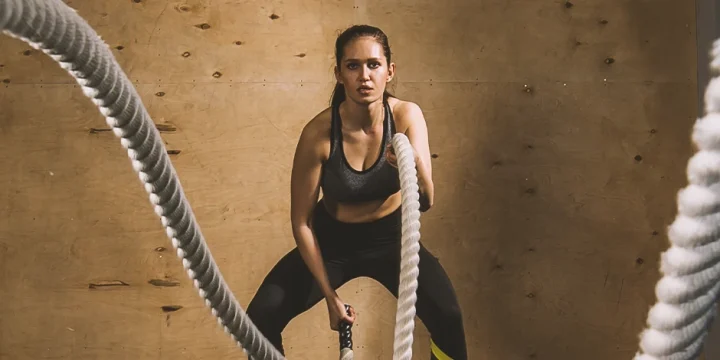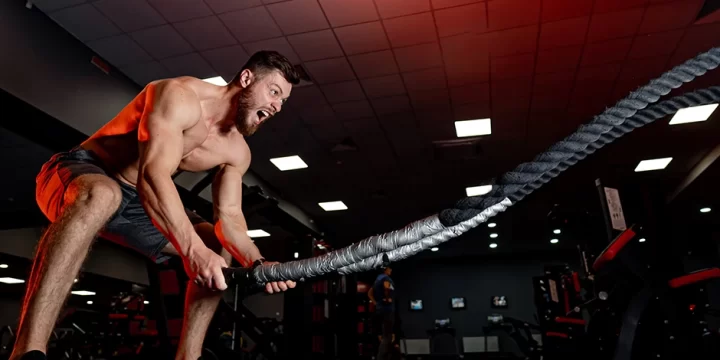The clamshell exercise is a fantastic activity that targets the hip, outer, and inner thigh muscles.
This simple yet effective movement can help strengthen your glutes and improve hip mobility and stability, making it a valuable addition to any fitness routine.
As a fitness professional, I have seen firsthand the positive impact of including clamshell exercises in training programs. In this article, I will share my knowledge and experience with this exercise, guiding you through the correct technique to optimize its benefits.
Quick Summary
- The clamshell exercise targets and strengthens the hip abductor muscles, specifically the gluteus medius, and minimus.
- By engaging in controlled hip abduction, the clamshell exercise promotes hip stability and improves lower body strength.
- According to Kenhub, the gluteus medius, worked out by clamshells, play a crucial role in stabilizing the pelvis during walking, running, and other lower body movements
- Regularly performaning clamshells can help enhance overall hip function, reduce the risk of hip and lower body injuries, and contribute to improved movement mechanics.
What Is the Clamshell Exercise?
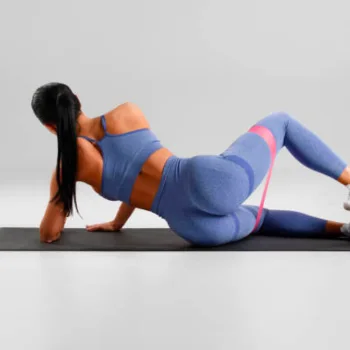
The clamshell exercise is a strengthening exercise that primarily targets the muscles of the hips and outer thighs.
It involves lying on your side with your knees bent and stacked on top of each other.
From this position, you lift your top knee away from the bottom knee, opening your legs like a clamshell.
The movement resembles the action of a clamshell opening and closing, hence the name.
The clamshell exercise is a simple, effective movement that is often used to improve hip mobility and stability, strengthen the gluteal muscles, and enhance overall lower body strength.
How To Perform Clamshells

While I haven't seen anyone injure themselves doing clamshells incorrectly, you can definitely reap all the benefits of the exercise by doing it with perfect form.
Here's how to perform a clamshell exercise correctly:
- Start by lying on your side with your hips stacked and legs on top of each other. Your knees should be bent at a 45-degree angle, and your head should rest comfortably on your arm or a pillow.
- Keeping your feet together, slowly lift your top knee towards the ceiling while keeping your feet in contact with each other.
- Open your knees as wide as you comfortably can, feeling the contraction in your glutes and outer thigh.
- Hold the position for a brief moment, and then slowly lower your knee back to the starting position.
- Repeat for the desired number of repetitions and then switch sides.
Clamshell Variations

There are several variations of the clamshell exercises that you can incorporate into your fitness routine.
These variations can target different muscles or add an extra challenge to the exercise. Here are a few examples:
1. Resistance Band Clamshell
Place your favorite home gym resistance band just above your knees and perform the clamshell exercise as usual.
The resistance band adds extra tension, intensifying the workout for your outer thigh muscles.
To perform the resistance band clamshell exercise:
- Tie a resistance band just above your knees.
- Lie on your side, stacking your feet together and resting your head on your arm or a pillow.
- Engage your core, press your feet together, and lift your upper knee until it aligns with your hip. Slowly lower it back down to the starting position. Aim for 10–15 reps on each side, keeping your core engaged and feet pressed together throughout the movement.
2. Clamshell with Dumbbell
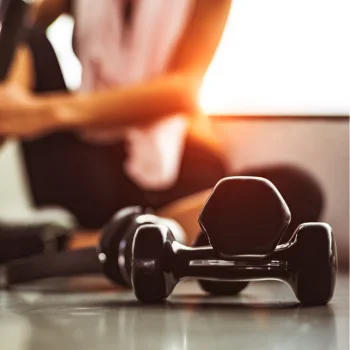
Hold a dumbbell or a small weight against the side of your top knee while performing the clamshell exercise.
The added weight increases the resistance and further challenges your hip and thigh muscles.
To perform the clamshell with dumbbell exercise:
- Lie on your side with your knees bent and stacked.
- Hold a dumbbell against the side of your top knee.
- Lift your top knee away from the bottom knee, opening your legs like a clamshell.
- Slowly lower your knee back down. Aim for 10-15 reps on each side, focusing on proper form and engaging the targeted muscles.
Learn More: Best Dumbbells for Your Home Gym in 2024
3. Side Plank Clamshell
Begin in a side plank position with your forearm on the ground and your body in a straight line.
From this position, perform the clamshell exercise by opening and closing your knees.
This variation engages your core muscles and adds an element of balance and stability to the exercise.
To perform the side plank clamshell exercise:
- Lie on your side, propped up on your forearm with your elbow beneath your shoulder.
- Lift your hips off the ground, creating a side plank position.
- Open your top knee away from the bottom knee, resembling a clamshell opening, while maintaining the side plank.
- Close the clamshell by lowering your top knee back down. Aim for 10-15 reps on each side, focusing on core engagement and controlled movement.
Muscles Trained

The muscles primarily trained with clamshell exercises are the gluteus medius, gluteus minimus, and external rotators of the hip, which are all part of the hip abductor muscles.
Clamshells also works the hip extensors, such as the gluteus maximus, and the hip flexors, such as the iliopsoas.
In addition to engaging the targeted muscles, the clamshell exercise also activates the core muscles as the individual maintains torso stabilization throughout the movement. Moreover, it helps enhance the range of motion in the hip joint.
The clamshell exercise primarily targets the following muscles.
1. Gluteus Medius
This muscle is located on the side of the hip and is responsible for hip abduction, which is the movement of the leg away from the midline of the body.
According to Kenhub, the gluteus medius play a crucial role in stabilizing the pelvis during walking, running, and other lower body movements [1].
2. Gluteus Maximus
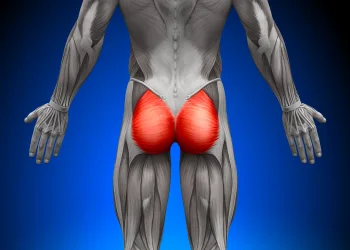
The largest muscle in the buttocks, the gluteus maximus, is also activated during the clamshell exercise.
It helps with hip extension, which is the movement of the leg backward [2].
Also Read: Gluteus Maximus Exercises
3. Tensor Fasciae Latae (TFL)
This small muscle is situated at the side of the hip and assists in hip flexion, abduction, and internal rotation. It stabilizes the hip joint with the gluteus medius [4].
4. External Rotators of the Hip
The external rotators of the hip, including muscles like the piriformis, gemellus muscles, and obturator internal and external, are engaged during the clamshell exercise. These muscles help rotate the hip outward.
Learn More: Best Hip Mobility Exercises
Clamshell Benefits

The clamshell exercises offer several benefits for individuals incorporating them into their fitness routine.
1. Hip and Glute Strength
The primary focus of the clamshell exercise is to strengthen the hip abductor muscles, including the gluteus medius and minimus.
By targeting the hip muscles, this exercise effectively addresses inadequate hip stabilization, providing benefits such as alleviating lower back pain and preventing hip and lower body injuries.
It also improves hip stability, enhances overall hip strength, and supports better functional movement patterns.
Read More: Glute Isolation Exercises Essential For Your Butt
2. Injury Prevention
Strong hip abductors contribute to better alignment and stability of the pelvis and lower body.
This can help reduce the risk of injuries, particularly those related to the hips, knees, and lower back.
By strengthening the hip abductors, the clamshell exercise aids in maintaining proper movement mechanics and reducing the strain on other areas of the body.
3. Core Activation

While performing the clamshell exercise, the core muscles, including the abdominals and obliques, are engaged to maintain stability and proper form, which is why I do them before squats.
This added benefit enhances core strength and stability, supporting overall posture and balance.
4. Rehabilitation and Pain Relief
The clamshell exercise is often prescribed in physical therapy programs for individuals with lower back pain or hip-related injuries.
It helps rehabilitate and strengthen the hip abductors, relieve pain, and restore normal movement patterns
“Incorporating the clamshell exercise into your routine can enhance hip strength and stability, benefiting various activities such as running, jumping, and lateral movements. It's an excellent exercise for improving athletic performance and reducing the likelihood of hip-related issues."
- Dr. Michael Anderson, Sports Rehabilitation Specialist
FAQs
Can You Do Clamshells Everyday?
Yes, you can do clamshells every day. However, it is important to listen to your body, make necessary adjustments to intensity or rest days, and prioritize proper recovery to avoid overuse injuries.
How Many Clamshell Exercises Should I Do?
You should do at least one variation of clamshell exercises for three sets of 25–30 reps. Intermediate and elite lifters can do more variations for a more defined workout.
Supplementing Your Clamshell Exercises
The clamshell exercise is a beneficial lower-body workout suitable for individuals of all fitness levels.
From my experience as a fitness expert, incorporating this exercise into your routine can improve hip strength, stability, and mobility, enhancing overall lower-body function.
For optimal results, consider combining the clamshell exercise with best tasting pre-workout supplements to boost endurance, energy, focus, and muscle activation during your workout sessions.
These supplements have proven effective in enhancing performance, allowing you to complete your sets and repetitions more efficiently.
References:
- https://www.kenhub.com/en/library/anatomy/gluteus-medius-and-minimus-muscles
- https://www.physio-pedia.com/Gluteus_Maximus
- https://www.physio-pedia.com/Tensor_Fascia_Lata
About The Author
You May Also Like
